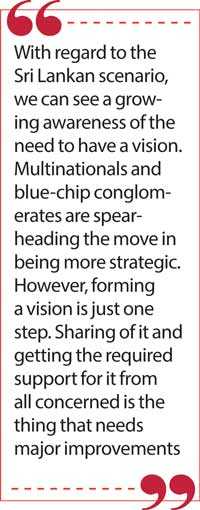Sunday Apr 20, 2025
Sunday Apr 20, 2025
Monday, 21 September 2020 00:20 - - {{hitsCtrl.values.hits}}

Both in the private and public sectors, change has become simply a necessity and a definite reality amidst the COVID-19 pandemic. How effective we are in driving change towards better, still remains to be seen
We are experiencing key changes in the way we work after the COVID-19 pandemic. Also, with the election excitement leading to exhaustive expectations, promises in political circles also point to change, change and more change. Several pitfalls are to be avoided in ensuring change for the better with wider positive implications. It is an opportune time to  revisit some fundamentals on driving change, in the context of COVID-19. Today’s column will attempt to do so.
revisit some fundamentals on driving change, in the context of COVID-19. Today’s column will attempt to do so.
Background
Whether we like it or not, change has become a necessity in an increasingly competitive world. As Charles Darwin said, “It is not the strongest species that survive, nor the most intelligent, but the ones who are most responsive to change”. Whether you distinct or extinct will depend on how you respond to change. It can be a case of being a victor or a victim. Such a scene is far more relevant to us than any other time because of the COVID-19 pandemic.
John Kotter, an authority on leadership and change claims that 70% of the major change initiatives in organisations fail. Based on his findings, he has identified an eight-stage process for achieving successful change in an organisation. According to Kotter, the first four steps in the transformation process help defrost a hardened status quo. “If change were easy, you wouldn’t need all that effort, he says. Steps five to seven then introduce many new practices. The last stage grounds the changes in the corporate culture and helps make them stick.
Driving change as an eight stage process
It is worthwhile to look into Kotter’s eight-stage process and to see its relevance to Sri Lankan managers facing daunting challenges with COVID-19. Let’s go step by step.
Step 1: Establishing a sense of urgency
According to Kotter, establishing a sense of urgency is necessary to gaining the cooperation needed to drive a significant change effort. We saw this worldwide with the wave of wearing face masks amidst COVID-19. Most companies ignore this step – indeed close to 50% of the companies that fail to make needed change make their mistakes at the very beginning.
Leaders who understand the importance of a sense of urgency are good at taking the pulse of their company and differentiating between complacency, false urgency and true urgency. For those that determine that true urgency is insufficient – and it often is – there are some tried and true approaches to developing it and one way that is almost certainly doomed to failure.
Sri Lankan managers, the way I see, have somewhat been successful in establishing a sense of urgency.
Step 2: Creating the guiding coalition
The COVID-19 task force successfully established in Sri Lanka is a case in point. No one person, no matter how competent, is capable of singlehandedly doing the vital things. These include developing the right vision, communicating it to vast numbers of people, eliminating all of the key obstacles, generating short term wins, leading and managing dozens of change projects and anchoring new approaches deep in an organisation’s culture. Putting together the right coalition of people to lead a change initiative is critical to its success.
Too often companies that start a change initiative create a low credibility committee to drive the change. When this happens, things limp along until the initiative falls apart. These efforts are doomed from the start and, as a result, the company’s competitive position gets a little weaker and the industry leader get a little further ahead.
Sri Lankan managers also face with the dilemma of selecting the right people in driving change. Sometimes such guiding coalitions have acted as true catalysts in ensuring change whilst others have ended up being catastrophic. We have many examples for both of the above cases.
Step 3: Developing a change vision
A clear vision serves three important purposes, says Kotter. First, it simplifies hundreds or thousands of more detailed decisions. Second, it motivates people to take action in the right direction even if the first steps are painful. Third, it helps to coordinate the actions of different people in a remarkably fast and efficient way. A clear and powerful vision will do far more than an authoritarian decree or micromanagement can ever hope to accomplish. 
As research has found, many visions are deceptively mundane. Often the vision is part of a larger system that includes strategies, plans and budgets. However, the vision is the glue that holds these things together and makes sense of them both for the mind and the heart. A good vision can demand sacrifices in order to create a better future for all of the enterprise’s stakeholders.
With regard to the Sri Lankan scenario, we can see a growing awareness of the need to have a vision. Multinationals and blue-chip conglomerates are spearheading the move in being more strategic. However, forming a vision is just one step. Sharing of it and getting the required support for it from all concerned is the thing that needs major improvements.
Step 4: Communicating the vision for buy-in
Gaining an understanding and commitment to a new direction is never an easy task, especially in complex organisations. As Kotter observes, under-communication and inconsistency are rampant. Both create stalled transformations.
Research has found that most companies under-communicate their visions by at least a factor of 10. A single memo announcing the transformation or even a series of speeches by the CEO and the executive team are never enough. To be effective, the vision must be communicated in hour-by-hour activities. The vision will be referred to in emails, in meetings, in presentations – it will be communicated anywhere and everywhere.
Sri Lankan managers are no better. We see major communication gaps in the areas of getting the buy-in for change initiatives. Every human being is interested in knowing how a new initiative can impact him/her. Some of the recent protests by several segments of the local society are a clear indication of this aspect not properly taking place.
Step 5: Empowering people and removing barriers
Kotter says that empowering employees involves addressing four major obstacles: structures, skills, systems and supervisors. Structural barriers are often the internal structures of companies work as cross-purposes to the change vision. An organisation that claims to want to be customer focused finds its structures fragment resources and responsibilities for products and services.
Realigning incentives and performance appraisals to reflect the change vision can have a profound effect on the ability to accomplish the change vision, observes Kotter. Management information systems can also have a big impact on the successful implementation of a change vision.
Another barrier to effective change can be troublesome supervisors. Often these managers have dozens of interrelated habits that add up to a style of management that inhibits change. They may not actively undermine the effort, but they are simply not “wired” to go along with what the change requires. Sri Lanka has got them in abundance.
Step 6: Generating short-term wins
According to Kotter, for leaders in the middle of a long-term change effort, short-term wins are essential. Running a change effort without attention to short-term performance is extremely risky. The Guiding Coalition becomes a critical force in identifying significant improvements than can happen between 6 and 18 months. Getting these wins helps ensure the overall change initiative’s success. Research shows that companies that experience significant short-term wins by 14 and 26 months after the change initiative begins are much more likely to complete the transformation.
To ensure success, short term wins must be both visible and unambiguous. The wins must also be clearly related to the change effort. Such wins provide evidence that the sacrifices that people are making are paying off. This increases the sense of urgency and the optimism of those who are making the effort to change. These wins also serve to reward the change agents by providing positive feedback that boosts morale and motivation.
As we have seen in Sri Lanka, short-term wins also tend to undermine cynics and self-serving resistors. Those critics who opposed military playing a role in tackling COVID-19 pandemic in Sri Lanka are silent now. Clear improvements in performance make it difficult for people to block the needed change. Likewise, these wins will garner critical support from those higher than the folks leading the change (bosses, board and shareholders). Finally, short-term wins have a way of building momentum that turns neutral people into supporters, and reluctant supporters into active helpers.
Step 7: Never letting up
Emphasis here is to use increased credibility to change systems, structures and policies that do not fit the vision. It also included hiring, promoting and developing employees who can implement the vision. Reinvigorate the process with new projects, themes, and change agents are a matter of priority.
In Sri Lanka we are mostly starters and not finishers. The relatively higher number of foundation stones compared to the completion plaques is one such evidence. Constant focus in driving change towards success is what we should do more. The way we experienced another 100-day period with no COVID-19 cases reported locally is a sign of encouragement of an engaged change initiative well executed.
Step 8: Incorporating changes into the culture
Culture is how people collectively behave with shared norms and values. Gert Hofstede, the veteran Dutch anthropologist calls it “collective mental programming”. Articulation of the connections between the new behaviours and organisational success is the essential requirement here. The need to develop the means to ensure leadership development and succession also occupies high prominence.
This also is a significant area for improvement for Sri Lankan managers. I have personally witnessed many instances how a massive change initiative dies down in the face of a leadership change. The crux of the change has not planted in the organisational culture and as such when people come and go, change initiatives also will be short-lived. The sure cure is to develop awareness and conduct attitudinal training in order to embed the change in the culture.
Way forward
The increased awareness of the hygienic habits thanks to COVID-19 should be sustained as a way of becoming a healthier society. As it is the case always, change invites you to move beyond a comfort zone. It applies to individuals, interactive teams and also to institutions. Both in the private and public sectors, change has become simply a necessity and a definite reality amidst the COVID-19 pandemic. How effective we are in driving change towards better, still remains to be seen.
(The writer can be reached through [email protected], [email protected] or www.ajanthadharmasiri.info.)
Discover Kapruka, the leading online shopping platform in Sri Lanka, where you can conveniently send Gifts and Flowers to your loved ones for any event including Valentine ’s Day. Explore a wide range of popular Shopping Categories on Kapruka, including Toys, Groceries, Electronics, Birthday Cakes, Fruits, Chocolates, Flower Bouquets, Clothing, Watches, Lingerie, Gift Sets and Jewellery. Also if you’re interested in selling with Kapruka, Partner Central by Kapruka is the best solution to start with. Moreover, through Kapruka Global Shop, you can also enjoy the convenience of purchasing products from renowned platforms like Amazon and eBay and have them delivered to Sri Lanka.
Discover Kapruka, the leading online shopping platform in Sri Lanka, where you can conveniently send Gifts and Flowers to your loved ones for any event including Valentine ’s Day. Explore a wide range of popular Shopping Categories on Kapruka, including Toys, Groceries, Electronics, Birthday Cakes, Fruits, Chocolates, Flower Bouquets, Clothing, Watches, Lingerie, Gift Sets and Jewellery. Also if you’re interested in selling with Kapruka, Partner Central by Kapruka is the best solution to start with. Moreover, through Kapruka Global Shop, you can also enjoy the convenience of purchasing products from renowned platforms like Amazon and eBay and have them delivered to Sri Lanka.